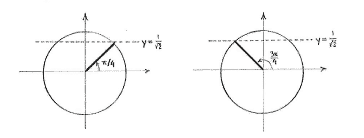Lösung 4.4:2d
Aus Online Mathematik Brückenkurs 1
(Unterschied zwischen Versionen)
K (hat „Solution 4.4:2d“ nach „Lösung 4.4:2d“ verschoben: Robot: moved page) |
|||
| Zeile 1: | Zeile 1: | ||
| - | + | Außer dass wir das Argument <math>5x</math> haben, ist dies eine gewöhnliche trigonometrische Gleichung auf der Form <math>\sin y = a\,</math>. Wir erhalten die Lösungen die <math>0\le 5x\le 2\pi</math> erfüllen, indem wir den Einheitskreis zeichnen, und wir erhalten die Lösungen <math>5x = \pi/4</math> und <math>5x = \pi - \pi/4 = 3\pi/4\,</math>. | |
[[Image:4_4_2_d.gif|center]] | [[Image:4_4_2_d.gif|center]] | ||
| - | + | Wir bekommen die allgemeine Lösung indem wir einen Multipel von <math>2\pi</math> zu den Lösungen addieren, | |
| - | {{Abgesetzte Formel||<math>5x = \frac{\pi}{4} + 2n\pi\qquad\text{ | + | {{Abgesetzte Formel||<math>5x = \frac{\pi}{4} + 2n\pi\qquad\text{und}\qquad 5x = \frac{3\pi}{4} + 2n\pi\,,</math>}} |
| - | where ''n'' is an arbitrary integer. | ||
| - | + | Dividieren wir beide Seiten durch 5 erhalten wir die Lösungen | |
| - | {{Abgesetzte Formel||<math>x = \frac{\pi}{20} + \frac{2}{5}n\pi\qquad\text{ | + | {{Abgesetzte Formel||<math>x = \frac{\pi}{20} + \frac{2}{5}n\pi\qquad\text{und}\qquad x = \frac{3\pi}{20} + \frac{2}{5}n\pi\,,</math>}} |
| - | + | ||
| - | + | ||
Version vom 21:12, 5. Apr. 2009
Außer dass wir das Argument \displaystyle 5x haben, ist dies eine gewöhnliche trigonometrische Gleichung auf der Form \displaystyle \sin y = a\,. Wir erhalten die Lösungen die \displaystyle 0\le 5x\le 2\pi erfüllen, indem wir den Einheitskreis zeichnen, und wir erhalten die Lösungen \displaystyle 5x = \pi/4 und \displaystyle 5x = \pi - \pi/4 = 3\pi/4\,.
Wir bekommen die allgemeine Lösung indem wir einen Multipel von \displaystyle 2\pi zu den Lösungen addieren,
| \displaystyle 5x = \frac{\pi}{4} + 2n\pi\qquad\text{und}\qquad 5x = \frac{3\pi}{4} + 2n\pi\,, |
Dividieren wir beide Seiten durch 5 erhalten wir die Lösungen
| \displaystyle x = \frac{\pi}{20} + \frac{2}{5}n\pi\qquad\text{und}\qquad x = \frac{3\pi}{20} + \frac{2}{5}n\pi\,, |

